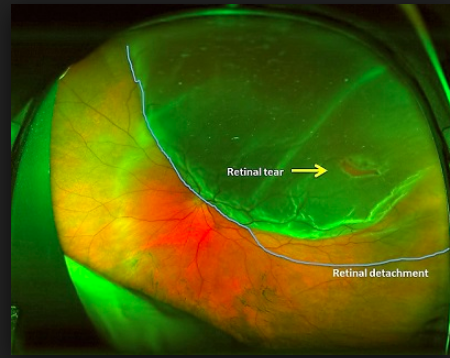Royce Chen, MD, is the Helen and Martin Kimmel Assistant Professor of Ophthalmology at Columbia University Medical Center and Attending Ophthalmologist at the New York-Presbyterian Hospital. He specializes in retinal disorders. Dr. Chen has graciously offered to do the following interview. Many of you will be very surprised by the power of lasers in correcting torn retinas and preventing blindness. I certainly was (1).
JB: Dr. Chen, thanks very much for taking the time to speak with me about how lasers are used for repair of damaged retinas. I was struck by the ease, lack of invasiveness, and minimal discomfort of the procedure, and I think that our readers would be interested in knowing what can be accomplished by using a laser. Can you give us a brief primer about retinal injuries? Why do they occur? What will a person who has a retinal injury experience?
RC: Most retinal tears occur spontaneously and are associated with traction from the vitreous humor upon the retina. The next question is, “what is the vitreous?” And the answer is that the vitreous is a clear gel composed mostly of water, but also of collagen and other proteins. At some point in time for most people, the vitreous will gradually separate from the back of the eye and result in something called a posterior vitreous detachment, or PVD. When the vitreous tugs hard enough on susceptible retina, a tear may develop. In most cases, tears in the retina occur spontaneously, but other factors, such as trauma, may directly cause tears as well

Retinal tear and detachment. Photo: Vision Avare
JB: It is very important to seek treatment for torn or detaching retinas as quickly as possible. Why is this? Approximately how much time do patients have to seek treatment before the injury gets worse?
RC: People with acute symptoms of new flashes and new floaters need to have a careful dilated exam as soon as possible because about 10% of the time, these symptoms may be caused by vitreous traction leading to a retinal tear. In turn, retinal tears may lead to retinal detachment and vision loss. Basically, fluid from the vitreous can sneak underneath the retina through the new break and then cause a separation of the retina from the underlying layer. This results in permanent damage to the vision cells of the eye. Every eye is different, and not every tear leads to a retinal detachment, but we do know that when people experience symptoms of flashing lights or new floaters, and we see a new retinal tear on exam, there is up to a 50% chance that the tear will lead to a retinal detachment if not treated. Because there is a relatively real chance of a big problem associated with these symptoms, we recommend that everyone who experiences new changes such as these should be evaluated as soon as possible.
JB: What is the worst case scenario? Can people permanently lose sight in the injured eye?
RC: The worst-case scenario is total blindness. If a partial retinal detachment is left untreated, the entire retina may detach, resulting in permanent visual loss. Of course, vitreoretinal surgeons are trained to fix retinal detachments, and we are very good at attaching retinas, but it’s definitely better to avoid getting a detached retina in the first place.
JB: Lasers are now the standard method for repairing tears in the retina. How was this managed before the advent of lasers?
RC: Lasers have actually been used for approximately 50 years for ophthalmic purposes, and some of the first treatments were performed at Columbia. Before lasers, people tried rest, bandaging, cautery, freezing, tacks, among other techniques.
JB: As I understand it, lasers work by heating the torn area, which causes scar tissue to form a "patch." Can you describe how this works?
RC: Lasers may cause photochemical and photothermal reactions in tissue. In the case of laser for retinal tears, the retina around a tear is heated with short laser burns that cause a scar with the underlying retinal pigment epithelium. Put simply, we use lasers to glue down the retina around the tear so that fluid can’t sneak through the tear and cause a detachment. It takes about 1-2 weeks for the scar to develop after the laser treatment.
JB: I find it astounding that the laser light must pass through the entire eye and focus on the retina in back. How can this be done without damaging other portions of the eye?
RC: Because laser has a property called coherence, it does not scatter and cause effects upon neighboring tissues. We have advanced tools that allow us to tune the power and choose the wavelength, and we can very precisely choose the location and depth of our laser treatment beam. This property of coherence is also why people on the ground can point lasers at pilots in the sky and bother them – if the light scattered in multiple directions on the way up to the sky, pilots wouldn’t have to deal with this problem.
JB: What are the limits of laser surgery? Is it ever necessary to use another procedure, such as traditional ocular surgery, to correct retinal disease or injury?
RC: Lasers can only be used to prevent a retinal detachment, but they (usually) cannot be used alone to fix an already detached retina. This is because we need the layer underneath the retina to absorb the energy from the laser to create the scar. When the retina is lifted up in a detachment, we cannot create the scar, and we cannot get rid of the fluid. When a retina is detached, we need to use surgical methods, such as vitrectomy, scleral buckle, and/or gas bubble insertion, in combination with laser, to fix the detachment.
JB: When are you going to lose the bow tie?
RC: Not losing the bow tie. But I will still wear a necktie once in a while. Why stick to one or the other? Life is more fun when there’s variety.
NOTES:
(1) I had several small retinal tears this year. Dr. Chen repaired them. The whole procedure took about a half hour and there was very minor discomfort.
(2) I have also interviewed Dr. LeeJee Suh, also at Columbia Ophthalmology, about how implantable Toric lenses can cure cataracts and correct vision at the same time. (See: Now You See It: Corrective Lens Implants - An Interview With Leejee H. Suh, M.D.)




